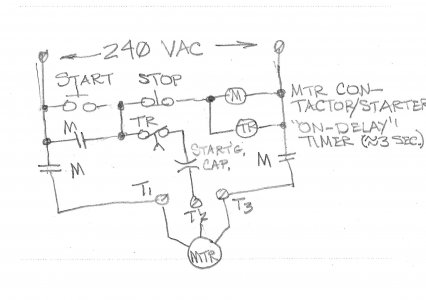On the right side of the sketch I wrote a 1-word description of what "M" & "TR" do; M is the motor starter or contactor coil & TR is the timer coil. & TR is usually a pneumatic timer with an air bleed adjustment which controls the time delay or the time delay can be done electronically, either by counting AC pulses or by charging or discharging a capacitor. In this particular case the timer needs to be an on-delay type where the time delay occurs when the timer coil first energizes.
It's been over 40 years since my AC fundamentals class so I don't remember all the theory & even less of the math involved. Caps cause current to lead the voltage by up to 90 degrees because maximum current through them occurs at maximum voltage & when they're fully discharged so they appear as a short across the voltage source. As they charge the current inrush decreases & the voltage across them increases, however, as the AC voltage crosses zero & reverses polarity, it, & the current discharges the capacitor & then begins to charges it in the opposite direction. Note that the phase shift created here is never over 90 degrees & 3-phase power is 120 degrees so this isn't a perfect solution but it works adequately.
And, no, unfortunately I can't explain how or why the voltage across an inductor or cap in an AC series circuit differ or exceed the applied voltage anymore [I was afraid someone would ask me this!] but I do remember this much: in an L-C series circuit the current through both is equal although the voltages can be different; in an L-C parallel circuit the voltage across both devices is equal but the currents through each can differ. And at resonance I think I recall that voltages are equal across both devices in a series circuit & currents are likewise equal through both devices in a parallel circuit. Hope this helps.

